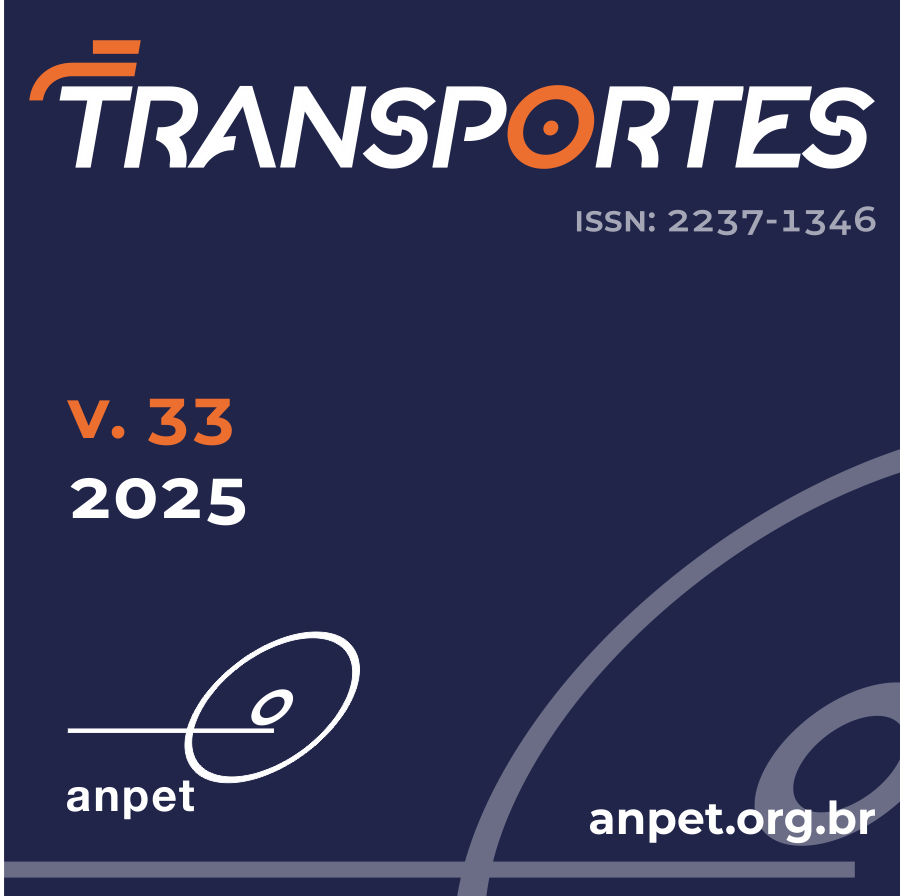Adaptation of the HCM-7 for estimating the level of service on a Brazilian two-lane rural highway with passing lanes
DOI:
https://doi.org/10.58922/transportes.v33.e3032Keywords:
Level of service. Traffic simulation. Passing lane.Abstract
The Highway Capacity Manual (HCM-7) is the primary document for analyzing capacity and level of service worldwide. The traffic data used in the development of the manual were obtained on North American roads, so adaptations must be made based on observed local conditions. The present study aimed to adapt the HCM-7 method to estimate the level of service on a Brazilian two-lane highway with passing lanes. The proposed method was based on traffic data produced with the Aimsun Next simulator, previously calibrated from traffic data obtained on a Brazilian highway (BR-040). Based on the simulation results, the coefficients of several equations in the manual were adjusted to assess the service measure Follower Density (FD) values in segments with passing lanes. It was observed that the adaptation of the HCM-7 method provided FD and Level of Service values close to the data found directly in the field.
Downloads
References
Aimsun (2020) Aimsun Next 20: Dynamic simulators user’s manual. Barcelona: Aimsun.
Al-Kaisy, A.; A. Jafari and S.S. Washburn (2017) Measuring performance on two-lane highways – Empirical investigation, Transportation Research Record: Journal of the Transportation Research Board, v. 2615, n. 1, p. 62-72. DOI: 10.3141/2615-08. DOI: https://doi.org/10.3141/2615-08
Bessa Jr, J.E. and J.R. Setti (2016) Avaliação de medidas de desempenho para rodovias de pista simples obtidas a partir de relações fluxo-velocidade, Transportes, v. 24, n. 3, p. 72-80. DOI: 10.14295/transportes.v24i3.1145. DOI: https://doi.org/10.14295/transportes.v24i3.1145
Bessa Jr, J.E. and J.R. Setti (2018) Evaluating measures of effectiveness for quality of service estimation on two-lane rural highways, Journal of Transportation Engineering, Part A: Systems, v. 144, n. 9, p. 04018056. DOI: 10.1061/JTEPBS.0000178. DOI: https://doi.org/10.1061/JTEPBS.0000178
Bessa Jr, J.E.; J.R. Setti and S.S. Washburn (2017) Evaluation of models to estimate percent time spent following on two-lane highways, Journal of Transportation Engineering, Part A: Systems, v. 143, n. 5, p. 1-9. DOI: 10.1061/JTEPBS.0000032. DOI: https://doi.org/10.1061/JTEPBS.0000032
Brêtas, D.A.A.; J.E. Bessa Jr and R.Q. Andrade (2024) Method to estimate the level of service in elongated roundabouts located on two-lane rural highways, Journal of Transportation Engineering, Part A: Systems, v. 150, n. 7, p. 04024032. DOI: 10.1061/ JTEPBS.TEENG-8071. DOI: https://doi.org/10.1061/JTEPBS.TEENG-8071
Chowdhury, T.; P.Y. Park and K. Gingerich (2024) Estimation of passing sight distance required for operation of truck platooning on two-lane highways in North America, IATSS Research, v. 48, n. 3, p. 347-56. DOI: 10.1016/j.iatssr.2024.05.003. DOI: https://doi.org/10.1016/j.iatssr.2024.05.003
Jeon, H. and R. Benekohal (2023) Comparison of analytical and simulation results for one-lane operation on low-volume two-lane highway, Transportation Research Record: Journal of the Transportation Research Board, p. 03611981231153652. DOI: 10.1177/03611981231153652. DOI: https://doi.org/10.1177/03611981231153652
Luttinen, R.T. (2000) Level of service on Finnish two-lane highways. In Transportation Research Circular E-C018: Fourth International Symposium on Highway Capacity. Washington, DC: TRB, National Research Council, p. 175-187.
Luttinen, R.T. (2001) Percent time-spent-following as performance measure for two-lane highways, Transportation Research Record: Journal of the Transportation Research Board, v. 1776, n. 1, p. 52-9. DOI: 10.3141/1776-07. DOI: https://doi.org/10.3141/1776-07
Maldonado, M.O.; M. Herz and J. Galarraga (2012) Modelacion de operacion en carreteras argentinas y recomendaciones de ajustes al Manual de Capacidad HCM 2010, Transportes, v. 20, n. 3, p. 51-61. DOI: 10.4237/transportes.v20i3.556. DOI: https://doi.org/10.4237/transportes.v20i3.556
Moreno, A.T. (2020) Estimating traffic performance on Spanish two-lane highways. Case study validation, Case Studies on Transport Policy, v. 8, n. 1, p. 119-26. DOI: 10.1016/j.cstp.2018.06.005. DOI: https://doi.org/10.1016/j.cstp.2018.06.005
Moreno, A.T.; C. Llorca and A. Garcia (2016) Operational impact of horizontal and vertical alignment of two-lane highways, Transportation Research Procedia, v. 15, p. 319-30. DOI: 10.1016/j.trpro.2016.06.027. DOI: https://doi.org/10.1016/j.trpro.2016.06.027
Moreno, A.T.; C. Llorca; S.S. Washburn et al. (2018) Operational considerations of passing zones for two-lane highways: Spanish case study, Promet (Zagreb), v. 30, n. 5, p. 601-12. DOI: 10.7307/ptt.v30i5.2776. DOI: https://doi.org/10.7307/ptt.v30i5.2776
Oliveira, J.K.S. and J.E. Bessa Jr (2022) Adaptation of the HCM for the analysis of two-lane rural highways without passing lanes in Brazil, Transportes, v. 30, p. 1-15. DOI: 10.14295/transportes.v30i3.2690. DOI: https://doi.org/10.14295/transportes.v30i3.2690
Penmetsa, P.; I. Ghosh and S. Chandra (2015) Evaluation of performance measures for two-lane intercity highways under mixed traffic conditions, Journal of Transportation Engineering, v. 141, n. 10, p. 1-7. DOI: 10.1061/(ASCE)TE.1943-5436.0000787. DOI: https://doi.org/10.1061/(ASCE)TE.1943-5436.0000787
Šarić, A. and I. Lovrić (2021) Improved volume–delay function for two-lane rural highways with impact of road geometry and traffic-flow heterogeneity, Journal of Transportation Engineering, Part A: Systems, v. 147, n. 10, p. 04021066. DOI: 10.1061/ JTEPBS.0000575. DOI: https://doi.org/10.1061/JTEPBS.0000575
Setti, J.R.; J.E. Bessa Jr; C.Y. Egami et al. (2011) Adaptação do HCM2000 para análise da capacidade e do nível de serviço em rodovias de pista simples no Brasil, Transportes, v. 19, n. 2, p. 66-78. DOI: 10.14295/transportes.v19i2.510. DOI: https://doi.org/10.14295/transportes.v19i2.510
Silva, F.A. (2019) Determinação do impacto de zonas de ultrapassagens proibidas e de faixas adicionais de subida em segmentos de rodovias de pista simples. Dissertação (mestrado). Universidade Federal de Minas Gerais, Belo Horizonte.
Silva, F.A.; J.E. Bessa Jr; A.L. Costa et al. (2022) Analysis of no-passing zones to assess the level of service on two-lane rural highways in Brazil, Case Studies on Transport Policy., v. 10, n. 1, p. 248-56. DOI: 10.1016/j.cstp.2021.12.006. DOI: https://doi.org/10.1016/j.cstp.2021.12.006
Silva, F.A.E.; J.E. Bessa Jr; A.L. Costa et al. (2021) Avaliação do efeito de faixas adicionais de subida em segmentos de rodovias de pista simples, Transportes, v. 29, n. 2, p. 1-16. DOI: 10.14295/transportes.v29i2.2359. DOI: https://doi.org/10.14295/transportes.v29i2.2359
TRB (1985) Special Report 209: Highway Capacity Manual. Washington, D.C.: Transportation Research Board, National Research Council.
TRB (2000) Highway Capacity Manual 2000. Washington, D.C.: Transportation Research Board.
TRB (2022) Highway Capacity Manual: A guide for multimodal mobility analysis (7th ed.). Washington, D.C.: Transportation Research Board.
Washburn, S.S.; D. Watson; Z. Bian et al. (2018) Improved analysis of two-lane highway capacity and operational performance. Washington, DC: Transportation Research Board. DOI: 10.17226/25179. DOI: https://doi.org/10.17226/25179
Yin, Y.; K. Choi; Y. Lee et al. (2022) Determining the most economical work zone lengths for rural highway rehabilitation projects, Journal of Management Engineering, v. 39, n. 2, p. 06022002. DOI: 10.1061/JMENEA.MEENG-5153. DOI: https://doi.org/10.1061/JMENEA.MEENG-5153
Downloads
Published
How to Cite
Issue
Section
License
Copyright (c) 2025 Ana Carolina Felício Bicalho, José Elievam Bessa Junior

This work is licensed under a Creative Commons Attribution 4.0 International License.
Authors who submit papers for publication by TRANSPORTES agree to the following terms:
- The authors retain the copyright and grant Transportes the right of first publication of the manuscript, without any financial charge, and waive any other remuneration for its publication by ANPET.
- Upon publication by Transportes, the manuscript is automatically licensed under the Creative Commons License CC BY 4.0 license. This license permits the work to be shared with proper attribution to the authors and its original publication in this journal, and to be adapted for non-commercial purposes, provided appropriate credit is given and any derivative works are distributed under the same terms.
- Authors are authorized to enter into additional separate contracts for the non-exclusive distribution of the version of the manuscript published in this journal (e.g., publishing in an institutional repository or as a book chapter), with recognition of the initial publication in this journal, provided that such a contract does not imply an endorsement of the content of the manuscript or the new medium by ANPET.
- Authors are permitted and encouraged to publish and distribute their work online (e.g., in institutional repositories or on their personal websites) after the editorial process is complete. As Transportes provides open access to all published issues, authors are encouraged to use links to the DOI of their article in these cases.
- Authors guarantee that they have obtained the necessary authorization from their employers for the transfer of rights under this agreement, if these employers hold any copyright over the manuscript. Additionally, authors assume all responsibility for any copyright infringements by these employers, releasing ANPET and Transportes from any responsibility in this regard.
- Authors assume full responsibility for the content of the manuscript, including the necessary and appropriate authorizations for the disclosure of collected data and obtained results, releasing ANPET and Transportes from any responsibility in this regard.









